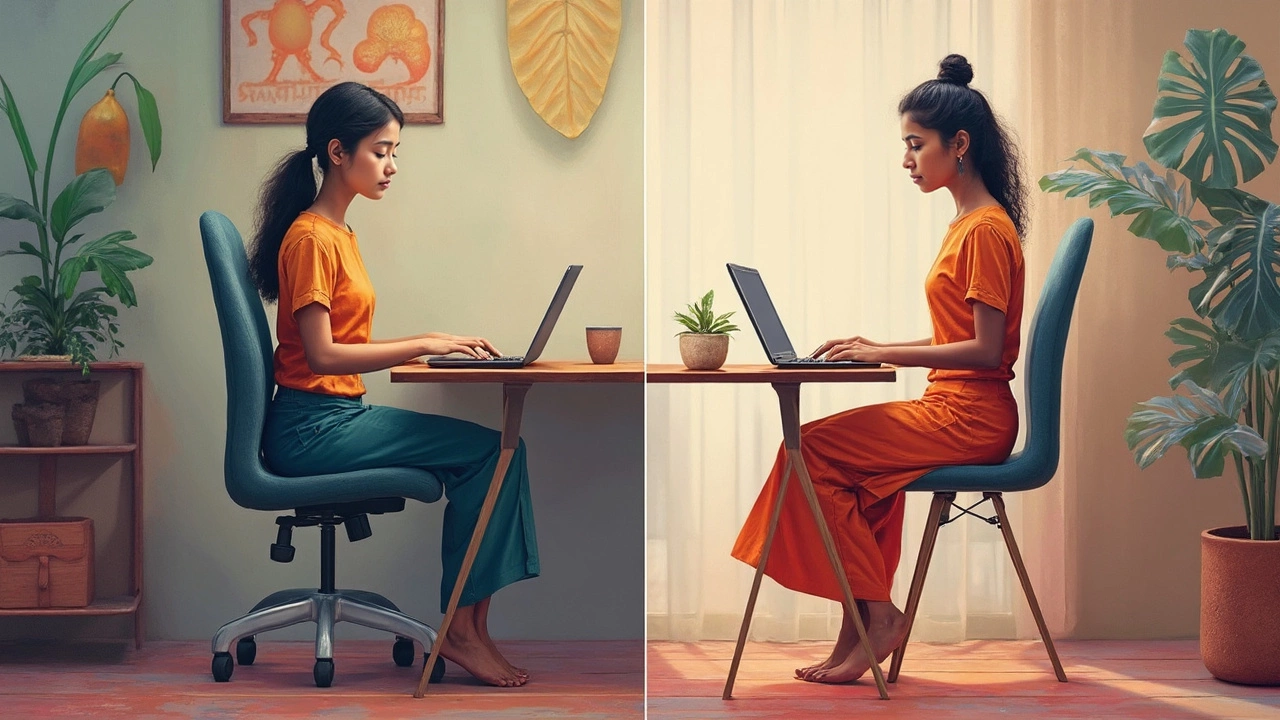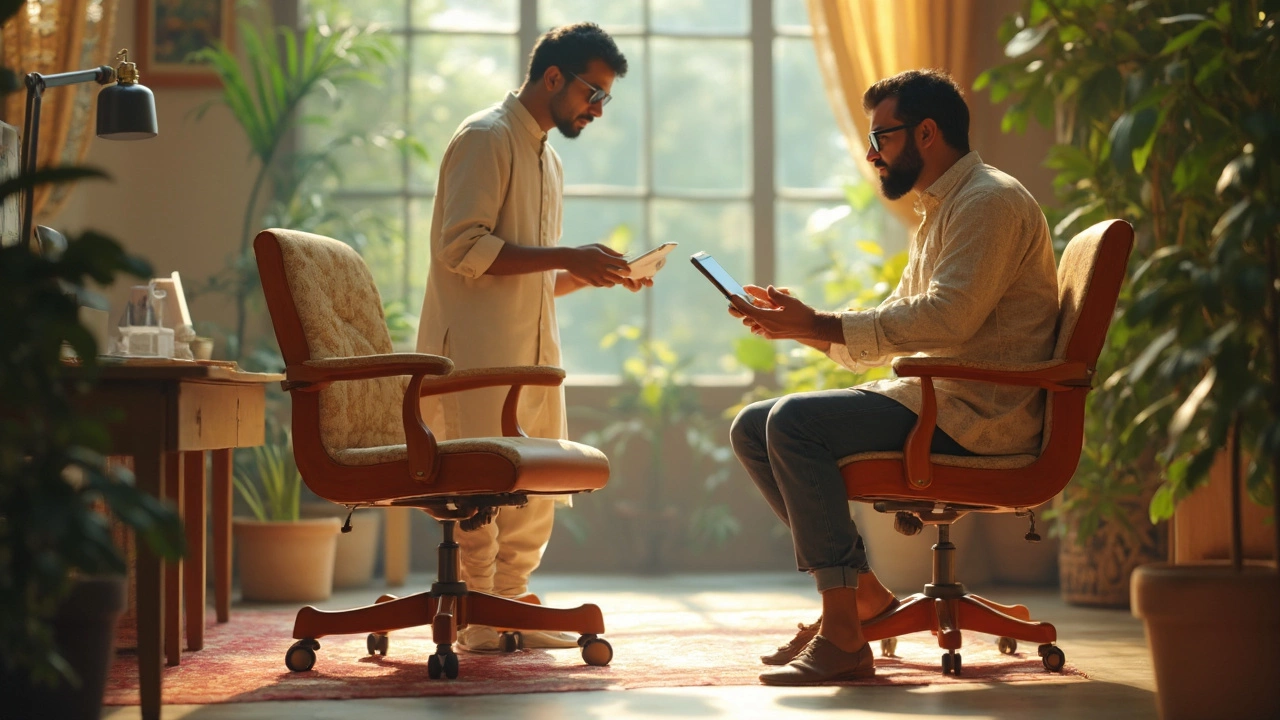Alright, let’s get down to something we all deal with but rarely think about: how we sit. We spend a good chunk of our day parked somewhere—which is why the chair vs. stool debate is more than just office gossip. It’s about making sure our backs don't revolt by 3 PM.
So, why does it matter if you’re on a chair or a stool? Chairs are like the cozy old sweater of seating. With back support, adjustable heights, and sometimes even armrests, they’re designed to let you sink in and focus on your work. But are they helping or hurting your posture long term? On the flip side, stools are like the personal trainers. They don’t pamper you, they keep you engaged—maybe too engaged if you like to kick back and relax.
Choosing between these two isn't just about comfort, it's about your back's future. So buckle up—or maybe stand up—and let's see what might work best for your daily grind.
- The Ergonomics of Chairs
- Stools: The Lean Machine
- Health Impacts of Poor Posture
- Practical Tips for Choosing
- Final Thoughts on Seating Choices
The Ergonomics of Chairs
So, let's talk chairs, the cornerstone of any decent office setup. These gems are designed with comfort in mind, and they’re not just about plush cushions. The main idea behind ergonomic chairs is to support your body in a healthy, neutral position. It’s all about keeping those postures spot-on, so your back, neck, and shoulders don’t ache like crazy after a few hours of typing or crunching numbers.
First up, we have the adjustable features. Ever noticed how some chairs seem to have a thousand levers? That’s because a good ergonomic office chair lets you tweak everything—height, tilt, back support, you name it. The goal is to align the spine naturally, maintaining the S-curve most of us should have when we're standing. Also, those armrests? They’re not just hand resters. Positioned right, they can help reduce strain on your shoulders and neck.
And let's not overlook lumbar support. This part of the chair curve is designed to fit snugly against the lower part of your spine, ensuring you don't sit like a banana all day. Keeping your lower back supported helps avoid that droopy posture we all naturally slump into as the hours tick by.
Here’s a neat fact: Research shows that sitting on a well-designed chair can reduce upper back and neck pain by up to 54%. That's a pretty convincing argument for investing in something that might save your back in the long run!
The icing on the cake? Most ergonomic chairs come with breathable fabric or mesh backs. Ideal for those marathon work days when you need everything on your side—without the sweaty back.
In a nutshell, while a chair seems like a simple piece of furniture, a well-designed one can be a powerhouse for posture improvement and comfort enhancement. It’s not just about sitting; it’s about sitting smart.
Stools: The Lean Machine
Ever sat on a stool and felt like you're working those core muscles? That's part of what makes a stool intriguing. With no back support, a stool pushes you to sit more actively. This means your body has to engage muscles just to keep you upright, potentially improving core strength if used correctly.
Now, stools come in all shapes and sizes—height-adjustable ones, ergonomic ones, and the classic wooden type you might find at your favorite cafe. So, what's the real scoop on stools? Without that comfy backrest, they naturally encourage a more upright posture. Your spine stays straighter, and you're less likely to slouch.
However, this active sitting style isn’t for everyone, especially for long hours. If you’re someone who’s moving about a lot or only perches for brief periods, stools can be great. They're lightweight and typically cheaper than your average office chair, making them accessible and versatile.
Let’s glance at some quick numbers:
| Chair Feature | Stool Benefit |
|---|---|
| Back Support | Core Engagement |
| Fixed Posture | Encourages Movement |
| High Cost | Budget-Friendly |
Trying out a stool could be the ticket if you’re looking for more movement throughout your workday. Moving a lot is actually a big plus—some folks swear by alternating between a stool and standing for maximum flexibility.

Health Impacts of Poor Posture
So, we’ve all heard that sitting with bad posture is bad for you, but what does that really mean? It’s not just about back pain. Poor posture can be the culprit behind headaches, reduced flexibility, and sometimes even less serious stuff like making you look less confident or alert.
Let’s talk specifics. When you slouch, you're putting extra pressure on your spine. This misalignment can lead to chronic back pain over time. Your spine isn't the only thing unhappy with the slouching, though. Poor posture can mess with your digestion, making those post-lunch slumps even worse.
Compared to a chair with proper back support, a stool forces your core muscles to work overtime. It’s not all bad—it might strengthen them over time—but doing it wrong or too much can strain muscles and ligaments. And hey, nobody wants that limp noodle feeling at the end of the day.
Now, let's throw in some numbers. A staggering 74% of office workers report suffering from pain due to poor posture. So, if you're feeling those aches, you're definitely not alone.
Practical Tips for Choosing
So, you're figuring out whether to stick with your current setup or switch things up. Let's break it down with some simple tips to help you make your choice between a chair or a stool for better posture.
First off, assess your daily needs. If you're at your desk for long hours, comfort and support with a good ergonomic chair might be the way to go. Look for features like lumbar support, adjustable height, and padded seats that adapt to your body.
Now, if you’re all about staying active even while sitting, a stool could spice up your routine. Consider what kind of stool fits your vibe. There are active stools that swivel or wobble a bit, which can help keep your core engaged.
Speaking of engagement, switching between sitting and standing can be a game-changer. If you opt for a stool, especially one that's height adjustable, make sure it's easy to move and fits your desk setup, so you can mix things up without a hassle.
- If back pain is a concern, try out different seat angles. For stools, a forward-leaning angle can help reduce the strain on your back.
- Notice the seat depth. Deeper seats might be more comfy for long use but can also cause slouching. Strike a balance based on your height and preference.
- Don't forget about the footrest. Especially with stools, having a spot to rest your feet can relieve pressure from prolonged sitting.
- Cost vs. comfort: Sometimes, investing a little more for quality can save you discomfort down the road. See it as an investment in your health.
Ultimately, it’s about finding what keeps you the most comfortable and alert. And remember, whatever you choose, taking breaks to stretch is still super important. Your body will thank you!

Final Thoughts on Seating Choices
So, after digging into both the classic chair and the trusty stool, where do we land on this seating showdown? Here's the deal: it's not just about picking a side, but understanding what each offers and what you need for your routine.
The chair might be your best friend if you’re parked at your desk for long stretches. Think about the perks: lumbar support, adjustable heights, and some models even come with reclining features. These options help you find that 'just right' spot to keep your posture happy. Plus, if you do a lot of typing, armrests can be a lifesaver.
But let's not count the stool out too quickly. The stool encourages active sitting, which keeps your core engaged. It's perfect for those who might need to hop on and off quickly or prefer a minimalist setup. It can even help remind you to take breaks since it's not as easy to zone out on a stool.
Here are some quick points to consider when choosing between the two:
- If you're dealing with back pain, a chair with good back support might be non-negotiable.
- If your work requires flexibility and frequent movements, a stool can do the trick.
- For a healthy balance, blending chair and stool usage throughout your day could be ideal.
Ultimately, the best choice depends on your specific needs and how you plan to use the seating. You might even consider an ergonomic assessment for your setup if you really want to optimize your office seating situation.
Statistically speaking, companies investing in ergonomic office furniture have reported a 25% increase in productivity and a meaningful reduction in employee discomfort. Keep that in mind when thinking about your own setup.
At the end of the day, your chair or stool should feel like an ally, supporting you without making you work hard to be comfortable. So, go ahead, find what fits you best and let your seating choice make your workday smoother.

